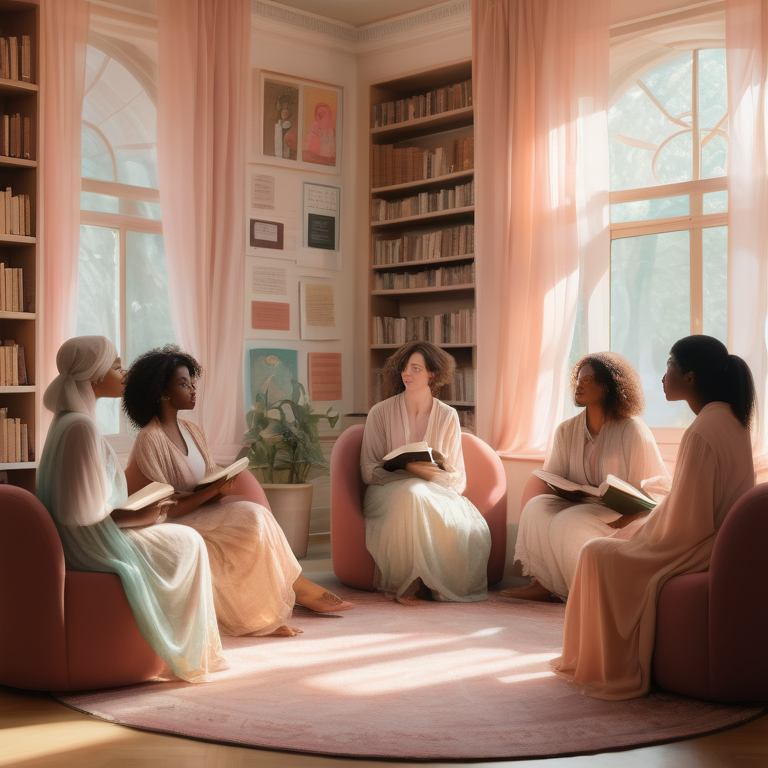Exploring Women’s Sexuality in Non-Western Literature

Key Highlights
- Non-Western literature offers a unique perspective on women’s sexuality, challenging Western norms and narratives
- Traditional narratives and the of colonialism shape the portrayal of women’s sexuality in non-Western literature
- Key themes in non-Western literature include liberation vs. oppression, the female body as a site of contestation and love, marriage, and autonomy
- Pioneering female authors such as Nawal El Saadawi and Mariama Bâ have made significant contributions to non-Western literature on women’s sexuality
- Regional perspectives on women’s sexuality vary in Middle Eastern, African, and South Asian literature
- Censorship and the intersection of women’s sexuality with religion and tradition are important considerations in non-Western literature
- FAQs provide insights into the influence of non-Western cultures, challenges faced by authors, the role of literature in sexual empowerment, and the impact of the digital age on the dissemination of non-Western literature on women’s sexuality
Introduction
Women’s sexuality has long been a subject of interest and exploration in literature. However, much of the focus has been on Western literature, often neglecting the rich and diverse perspectives offered by non-Western literary traditions. In recent years, there has been a growing recognition of the importance of exploring women’s sexuality in non-Western literature, as it provides a unique and nuanced understanding of gender, sexuality, and cultural norms. This blog, inspired by The Guardian’s list of African, Asian, Indian, and Middle Eastern books that every student should read, will delve into the world of non-Western literature and explore how it portrays women’s sexuality, challenging Western narratives and shedding light on the experiences of women in different cultural contexts.
Historical Context of Women’s Sexuality in Non-Western Literature
To understand the portrayal of women’s sexuality in non-Western literature, it is essential to consider the historical context in which these narratives emerged. Unlike Western literature, which has been influenced by centuries of patriarchal norms, non-Western literature reflects the cultural and social dynamics of diverse regions. Colonialism played a significant role in shaping the narratives and perspectives on women’s sexuality in non-Western literature, as it introduced Western ideals and norms that often clashed with traditional values and beliefs.
The role of traditional narratives
In non-Western literature, traditional narratives have played a crucial role in shaping the portrayal of women’s sexuality. These narratives reflect the cultural traditions, values, and beliefs of a particular region or community. They often explore themes of love, marriage, and the role of women in society. Traditional narratives provide a lens through which non-Western authors can challenge and subvert societal norms, offering alternative perspectives on women’s sexuality. By drawing on mythology, folklore, and cultural traditions, these narratives provide a rich and complex understanding of the experiences of women in non-Western societies.
Impact of colonialism on storytelling
The impact of colonialism on storytelling in non-Western literature cannot be understated. Colonial powers imposed their own cultural values and norms on colonized societies, often suppressing indigenous traditions and narratives. This had a profound effect on the portrayal of women’s sexuality in non-Western literature. Western ideals of femininity, modesty, and morality were introduced, often in conflict with traditional beliefs and practices. Non-Western authors, both during and after colonial rule, have grappled with these conflicting influences, using storytelling as a means to assert their cultural identity and challenge the dominant narratives imposed by colonial powers.
Key Themes in Non-Western Literature on Women’s Sexuality
Non-Western literature on women’s sexuality explores a range of key themes that are distinct from Western narratives. These themes include the tension between liberation and oppression, the female body as a site of contestation and the complexities of love, marriage, and autonomy. By examining these themes, non-Western literature offers a deep and nuanced understanding of women’s sexuality, challenging Western notions and shedding light on the diverse experiences of women in different cultural contexts.
Liberation vs. oppression
One of the key themes in non-Western literature on women’s sexuality is the tension between liberation and oppression. Many non-Western societies have patriarchal structures that restrict women’s sexual autonomy and agency. However, non-Western authors also highlight moments of resistance and empowerment, where women challenge societal norms and assert their own desires. These narratives explore the complexities of navigating societal expectations while seeking personal freedom and liberation. By examining the experiences of women in non-Western societies, non-Western literature offers a rich and nuanced understanding of the challenges and triumphs of women’s sexuality.
The female body as a site of contestation
In non-Western literature, the female body often becomes a site of contestation, subject to societal expectations, cultural norms, and religious beliefs. Non-Western authors explore the ways in which women’s bodies are policed, objectified, and controlled, as well as the ways in which women resist and reclaim their bodies. These narratives challenge the notion of the female body as a passive object and instead present it as a source of power, agency, and resistance. By examining the complexities of the female body in non-Western societies, non-Western literature provides a unique and empowering perspective on women’s sexuality.
Love, marriage, and autonomy
Love, marriage, and autonomy are key themes in non-Western literature on women’s sexuality. Non-Western societies often place a strong emphasis on family, tradition, and societal expectations when it comes to love and marriage. Non-Western authors explore the complexities of navigating these expectations while seeking personal happiness, love, and agency. They examine the ways in which women negotiate their desires, make choices about their relationships, and assert their autonomy within the constraints of cultural and social norms. By delving into the intricacies of love, marriage, and autonomy, non-Western literature offers a nuanced understanding of women’s sexuality in different cultural contexts.
Pioneering Female Authors in Non-Western Literature
Pioneering female authors in non-Western literature have made significant contributions to the portrayal of women’s sexuality. Their works challenge societal norms, subvert traditional narratives, and provide a unique perspective on the experiences of women. Two notable examples are Nawal El Saadawi and Mariama Bâ. Nawal El Saadawi, an Egyptian author and activist, has written extensively on women’s rights, sexuality, and gender inequality in the Arab world. Mariama Bâ, a Senegalese author, is known for her novel “So Long a Letter,” which explores themes of polygamy, female empowerment, and the complexities of love and marriage. These female authors have paved the way for contemporary voices in non-Western literature on women’s sexuality.
Nawal El Saadawi’s contributions
Nawal El Saadawi is a pioneering figure in non-Western literature, particularly when it comes to the portrayal of women’s sexuality. Through her novels, essays, and activism, she has challenged societal norms and patriarchal structures that oppress women. Saadawi’s works, including her most famous novel Palace Walk, explore themes such as female circumcision, sexual harassment, and the intersection of gender and religion in the Arab world. She has been a vocal advocate for women’s rights and has faced significant backlash and censorship for her views. In 2021, Saadawi was nominated for the Nobel Prize in Literature for her contributions to non-Western literature, specifically her exploration of women’s sexuality, paving the way for a more open and honest discussion of these important topics, challenging cultural taboos and advocating for gender equality.
The legacy of Mariama Bâ
Mariama Bâ is another influential figure in non-Western literature, known for her novel “So Long a Letter.” Bâ’s work explores themes of polygamy, female empowerment, and the complexities of love and marriage in Senegalese society. “So Long a Letter” is written in the form of a letter from a woman to her best friend, and it offers a deeply personal and intimate exploration of the protagonist’s experiences. Bâ’s novel challenges traditional gender roles and highlights the resilience and strength of women in the face of societal expectations. Her work continues to inspire contemporary authors and readers, leaving a lasting legacy in the realm of non-Western literature on women’s sexuality.
Contemporary voices and their impact
In addition to pioneering female authors, contemporary voices in non-Western literature have made a significant impact on the portrayal of women’s sexuality. These authors come from diverse backgrounds and regions, each offering a unique perspective on the experiences of women. Their works challenge societal norms, explore the complexities of gender and sexuality, and advocate for women’s rights. Through their storytelling, these contemporary voices provide a platform for marginalized voices, challenge cultural taboos, and promote inclusivity and diversity in non-Western literature. Their contributions continue to shape the landscape of non-Western literature on women’s sexuality and pave the way for future generations of authors and readers.
Regional Perspectives on Women’s Sexuality
Women’s sexuality is portrayed differently in non-Western literature based on regional perspectives. Middle Eastern narratives often grapple with cultural and religious norms, exploring themes of modesty, honor, and the role of women in society. African stories of empowerment challenge gender roles and highlight the resilience and strength of women in the face of adversity. South Asian reflections on gender and sexuality often navigate the complexities of arranged marriages, societal expectations, and the tension between tradition and modernity. Each region offers a unique lens through which to explore women’s sexuality, shedding light on the diverse experiences of women across different cultural contexts.
Middle Eastern narratives
Middle Eastern narratives on women’s sexuality often grapple with the complexities of cultural and religious norms. These narratives explore themes of modesty, honor, and the role of women in society. They often challenge societal expectations and shed light on the experiences of women in the Middle East. Authors such as Nawal El Saadawi and Hoda Barakat have been instrumental in bringing these narratives to the forefront, offering a nuanced understanding of the challenges and realities faced by women in the region. Middle Eastern literature on women’s sexuality provides a unique perspective on the intersection of culture, religion, and gender, challenging Western assumptions and shedding light on the diversity of women’s experiences in the region.
African stories of empowerment
African literature offers powerful stories of empowerment that challenge gender roles and highlight the resilience and strength of women. These narratives explore themes of identity, tradition, and the complexities of navigating societal expectations. Authors such as Chimamanda Ngozi Adichie and Buchi Emecheta have made significant contributions to African literature on women’s sexuality, presenting multifaceted and authentic portrayals of African women. These stories celebrate the agency and autonomy of African women, challenging Western stereotypes and providing a more nuanced understanding of the experiences of women in the continent.
South Asian reflections on gender and sexuality
South Asian literature offers a rich and diverse portrayal of women’s sexuality, exploring the complexities of arranged marriages, societal expectations, and the tension between tradition and modernity. Authors such as Arundhati Roy and Kamila Shamsie have delved into these themes, presenting complex and nuanced portrayals of South Asian women. These narratives challenge cultural taboos and shed light on the experiences of women grappling with societal expectations and personal desires in countries like India. South Asian literature on women’s sexuality provides a unique perspective on the intersection of culture, tradition, and gender, offering a deep and nuanced understanding of the experiences of women in the region.
Censorship and Women’s Sexuality in Literature
Censorship plays a significant role in shaping the portrayal of women’s sexuality in non-Western literature. In many non-Western societies, topics related to women’s sexuality are considered taboo or controversial. As a result, authors often face challenges and censorship when discussing these topics in their work. Censorship can limit the representation of women’s experiences and perpetuate stereotypes and misconceptions. However, non-Western authors and activists continue to push boundaries and challenge censorship, using literature as a tool for empowerment and social change.
Challenges faced by authors
Authors addressing women’s sexuality in non-Western contexts face numerous challenges. They must navigate cultural norms, societal expectations, and potential backlash from conservative elements within their communities. Speaking openly about women’s sexuality can be seen as a violation of cultural and religious values, leading to censorship and personal risks for authors. However, many authors brave these challenges to bring forth honest and authentic narratives, challenging stereotypes and advocating for gender equality. Their work paves the way for open discussions and a more inclusive portrayal of women’s sexuality in non-Western literature.
The role of translation in global understanding
Translation plays a crucial role in the dissemination of non-Western literature on women’s sexuality. Translating works from one language to another allows for a broader audience to access and engage with these narratives. It promotes cultural exchange, understanding, and appreciation of diverse perspectives. However, translation also presents challenges, as nuances and cultural context can be lost in the process. Translators must navigate linguistic and cultural differences to ensure the integrity of the original work. Despite these challenges, translation remains an essential tool in fostering global understanding and appreciation of non-Western literature on women’s sexuality.
The Intersection of Women’s Sexuality with Religion and Tradition
Religion and tradition often intersect with women’s sexuality in non-Western contexts, shaping societal expectations and norms. The portrayal of women’s sexuality in non-Western literature reflects this complex intersection, exploring the tensions and negotiations between cultural beliefs and personal desires. Authors navigate the complexities of religious teachings, cultural traditions, and societal expectations, shedding light on the ways in which women navigate their sexuality within these frameworks. By examining the intersection of women’s sexuality with religion and tradition, non-Western literature provides a unique and nuanced understanding of the experiences of women in different cultural contexts.
Conflicts and reconciliations
The intersection of women’s sexuality with religion and tradition often gives rise to conflicts and reconciliations. Non-Western literature explores the ways in which women navigate these conflicts, whether it be reconciling personal desires with religious teachings or challenging traditional gender roles. These narratives shed light on the complexities of navigating cultural and religious expectations while seeking personal fulfillment and autonomy. Authors delve into the internal struggles faced by women, the negotiations they make, and the ways in which they challenge societal norms. By examining the conflicts and reconciliations that arise at the intersection of women’s sexuality with religion and tradition, non-Western literature provides a nuanced understanding of the complexities of women’s experiences.
The evolving interpretations of sacred texts
Sacred texts in non-Western literature are subject to a continual process of reinterpretation, reflecting the evolving societal norms and values of their respective cultures. This dynamic nature of interpretation is influenced by a multitude of factors, including cultural shifts, historical contexts, and the evolution of belief systems over time. Authors often infuse these texts with contemporary relevance, presenting fresh perspectives that challenge established views. Through this ongoing process, sacred narratives are rejuvenated, offering new insights into various aspects such as women’s roles, sexuality, and agency within these traditions.
The reinterpretation of these sacred texts serves not only to preserve cultural heritage but also to provide a deeper comprehension of the intricate relationship between religious teachings and individual experiences. By enriching the literary landscape of non-Western traditions, these reimagined narratives contribute to a broader understanding of diverse cultures and belief systems across different regions. The continuous reinterpretation of sacred texts underscores the significance of adaptability and open-mindedness in exploring the complexities inherent in non-Western literature.
Conclusion
In exploring women’s sexuality in non-Western literature, we uncover rich narratives shaped by historical contexts, traditional norms, and contemporary voices. Key themes like liberation, love, and autonomy resonate through pioneering works by authors such as Nawal El Saadawi and Mariama Bâ. These stories offer diverse regional perspectives, from Middle Eastern narratives to African empowerment tales and South Asian reflections. Despite censorship challenges, literature remains a powerful tool for discussing women’s sexuality, intersecting with religion and tradition. By understanding these narratives, we can appreciate the complexities of gender dynamics across cultures. What are your thoughts on the portrayal of women’s sexuality in non-Western literature? Share in the comments below.
Frequently Asked Questions
How do non-Western cultures influence the portrayal of women’s sexuality in literature?
Non-Western cultures influence the portrayal of women’s sexuality in literature by providing diverse perspectives, challenging Western norms, and shedding light on the experiences of women in different cultural contexts. These narratives offer a more inclusive and nuanced understanding of women’s sexuality.
What challenges do authors face when discussing women’s sexuality in non-Western contexts?
Authors addressing women’s sexuality in non-Western contexts face challenges such as cultural taboos, censorship, and potential backlash from conservative elements within their communities. Speaking openly about women’s sexuality can be seen as a violation of cultural and religious values, leading to personal risks for authors.
Can literature be a tool for sexual empowerment in non-Western societies?
Yes, literature can be a powerful tool for sexual empowerment in non-Western societies. By challenging societal norms, providing a platform for marginalized voices, and advocating for gender equality, empowers women to assert their sexuality and navigate the complexities of cultural expectations.
How has the digital age affected the dissemination of non-Western literature on women’s sexuality?
The digital age has had a significant impact on the dissemination of non-Western literature on women’s sexuality. Online platforms and digital publishing have made these narratives more accessible to a global audience, facilitating cultural exchange and fostering a greater understanding of women’s experiences in different cultural contexts.




